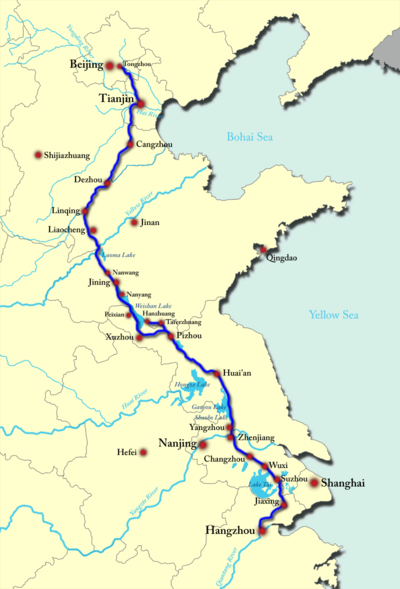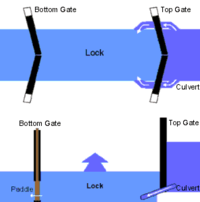AS 201 Sui, Tang and Song Dynasties
Sui (581-617)
--Reunited China after 350 Years of Disunity;
--Buddhism Spread as Sui Monarchs were Buddhist
--Built the Grand Canal that linked the Yellow and Yangzi Rivers:
With the recorded labor of five million men and women, the first major section of the Grand Canal was completed in the year 605. The Grand Canal was fully completed under the second Sui emperor, from the years 604 to 609.
This allowed the southern area to provide grain to the northern province. Running alongside and parallel to the canal was an imperial roadway and post offices supporting a courier system. The government also planted an enormous line of trees.

They also pioneered canal lock gates to regulate water levels for the canal. Double slipways were installed to haul boats over when the difference in water levels were too great for the flash lock to operate.
Adapted from: http://en.wikipedia.org/wiki/Grand_Canal_%28China%29
The Grand Canal in China is generally regarded as the oldest and longest man-made canal in the world. It begins in the north at Beijing and ends at Hangzhou, traversing on its way south the four provinces of Hebei, Shandong, Jiangsu and Zhejiang....With a total length of 1,794 kilometers, the canal links up the five large rivers of Haihe, Huanghe (the Yellow River), Huaihe, Changjiang (the Yangtze River) and Qiantangjiang. In ancient times, it served as the main artery of communication between north and south.
Adapted from: http://www.chinatown-online.com/cultureeye/highlights/grand.htm
Tang (617-960)
--Largest capital city called Chang-An at Xian;
--Some 2 million inhabitants
--Model for Heian Capital in Japan (see pictures p. 78 of textbook)
--Cosmopolitan cities with pilgrims arriving from Central Asia (silk Road), Japan, Korea, Vietnam, Tibet
--Many foreign merchants
--so many foreign communities and religions:
--Nestorian Christianity, Manichaeism, Zoroastrianism, Judaism, Islam and, of course, Buddhism
--Cha'an and Zen Buddhism thrive
--Large Aristocratic families still dominate but now local elites with education growing, too
--Examinations for holding office were held
--candidates judged on deportment, appearance, speech, calligraphy--i.e., educated, proper, responsible men
--Tang = era of great poets: Bai Juyi (much admired by Heian courtiers), Du Fu and Li Bo
--Tang = an era of high sophisticatin and cultural development;
--As Sulaiman the Merchant, Arabic traveler writes in 851:
--Whether poor or rich, young or adult, all Chinese learn to trace the characters and to write....
--When the cost of living increases, the government issues food from its reserves and sells it at less than the market price ("Ever Normal Granaries")
--If a man is poor, he receives from the Treasury the cost of medicines;
--In each town there is a school and a school master for the instruction of the poor and their children;
--these school masters are supported by the Treasury
--China is more healthy [than India]...One never sees a blindman, a cripple, or an infirm person there whereas many are found in India...
Song Dynasty (960-1127)
--Perhaps the most advanced society in the world:
--"Maturation" of the Chinese Spirit - the Best of the Best
--Invention and spread of Paper and Printing
--so growth of literacy, Education
--an age of great creativity and invention
--great Song ink painters and landscape painters
--formalization of Examination system
--Commercial Revolution: a national market for porcelain, silk, copper coins, paper, books, lacquerware, jewelry
--increase in Agricultural Productivity--new crops, seeds, agricultural techniques spreaad
--supports larger population 100-120,000 more than double Han and Tang
--growth of Cities and Urban Lifestyles
--10 cities boast 1 million population
--a national urban bourgeosie emerges
--Examination system meant the rise of a Scholar-Official class: this class now larger, better-educated, greater status, non-aristocratic
--so we say it was now "Meritocratic"
--3 levels of the Exam held every 3 years:
1. Local level--certified as "flowering talent"
2. Provincial level--"recommented talent"
3. Capital/Palace Exams = produces the chin-shih or "Scholar Official"
--Confucian texts "streamlined" into the Four Books:
1.The Analects
2. The Great Learning (大学)
3. Doctrine of the Mean (中庸 )
4. Mencius
--A revitalized "Neo-Confucianism" emerges
--led by Zhu Xi (1130-1200) = the supreme synthesis; practiced Chan and loved the Book of Changes
-- also, a response to Buddhism
-- posits a "Supreme Ultimate"--Tai-chi (太極) like an upgrade to the Dao
--reached through the study of Principles (理) and Cosmic Ether (気)
--two approaches:
--study of li (理 principle) of things: "the extension of knowledge lies in the investigation of things." Opens door for rational inquiry, scientific learning?
--study of mind (心); bring unity through investigating things from the Outside (principles) coupled with investigation of the inner-person through the Mind; related to meditation, Daoism, inner work, self-cultivation
--Spread of Printng and Books means more people reading and studying for exams
--roughly 200 successful candidates per year, 100 chin-shih
--landed Gentry class as local elites part of this new Song society
--Many new inventions and technologies
--Printing, Gunpowder and Magnet (magnetic compass) = the big 3 discoveries/inventions
--the Chinese come up with Waterwheel, Windmill, water-powered textile machinery driving 32 spindles
-- metallurgical bellows
--coal--> iron ore from coke--> better agricultural tools
--astronomical clock
--Maps
-- new medical advances
--stone segmental arched bridges
--watertight bulkhead compartments on ships
--roads, transporation, shipping, commerce, all grow--a world in motion
-- So the Song is a dynamic, literate, urban, sophisticated society
--a transformed, upgraded version of Han, Sui and Tang
--but now even improved/better
--Marco Polo would visit after Song has fallen and Mongols rule, but, still, he could see how amazing this era was. His writings on China are legendary.
--He wrote things like "The natives of the city of Hangzhou are men of peaceful character...They know nothing of handling arms, and keep none in their houses. You hear of no feuds or noisy quarrels or dissensions among them.
--They are thoroughly honest and truthful, and there is such a a degree of good will and neighborly attachment among both men and women that you would take the people who live on the same street to be all one family."
--Other travelers like Friar Odoric write:
--"In that country the number of people is so great that among us here it would be deemed impossible.
--And no man ever seeketh alms, however poor he may be, as long as he can do anything with his his own hands to help himself.
--But those who have fallen into indigence and infirmity are well looked after and provided with the necessities."
--These descriptions would suggest that to European eyes, much was going well in the Song dynasty; society was being well-managed by the scholar-officials and their civil service, and their cities were something to behold!
